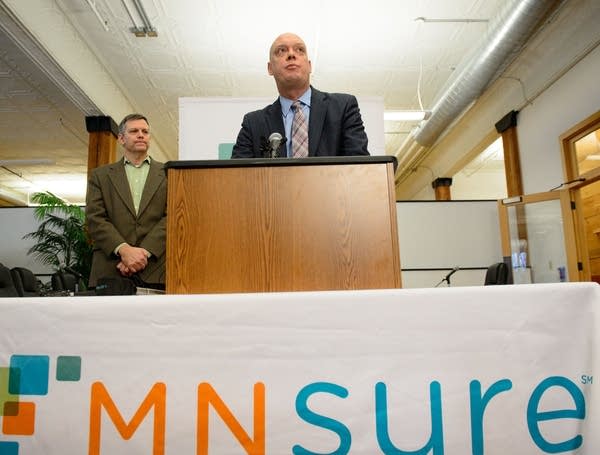MNsure interim CEO: More work needs to be done

Go Deeper.
Create an account or log in to save stories.
Like this?
Thanks for liking this story! We have added it to a list of your favorite stories.
Despite ongoing efforts to fix the state's new health insurance website, only a handful of problems have been fixed, MNsure's top official said Wednesday.
The comments from interim CEO Scott Leitz came after a team of IBM's tech whizzes have been working in St. Paul for nearly a month to help fix the problem-plagued MNsure website. They also follow a planned, two-day maintenance shutdown of the website last weekend.
"We have a site that works OK for a decent chunk of the population," said Leitz, who took over at MNsure after the site's former executive director, April Todd-Malmlov, stepped down last month. "But it has challenges for another set of the population and we need to improve that piece moving forward."
Leitz said he doesn't think the site will work as intended in the near future. Instead, some people seeking insurance will be enrolled manually. He also said the transfer of accurate enrollment information from MNsure and insurance companies is still unreliable.
Turn Up Your Support
MPR News helps you turn down the noise and build shared understanding. Turn up your support for this public resource and keep trusted journalism accessible to all.
"I don't anticipate by the end of March it's going to be flowing seamlessly," he said. "I don't think that's an expectation that can be set, and I don't think it's one that can be fulfilled if we set it."
Leitz's comments come at a critical time for MNsure.
An enrollment deadline for people to get coverage starting on Feb. 1 looms. The state's Legislative Auditor has expressed deep concern about the site's troubled operations and whether state officials have managed the project adequately. And MNsure is receiving increased scrutiny from Gov. Mark Dayton and the Legislature.
Meanwhile, MNsure announced Wednesday an outside firm will review the site, its contractors and MNsure's management structure.
TECH SURGE
In mid-December, Gov. Mark Dayton demanded that IBM Curam dispatch tech workers to St. Paul to fix a litany of problems with the company's portion of the MNsure system. In a letter to the company he said that defects in the software the state spent $3.9 million on "have seriously harmed Minnesotans." IBM Curam was contracted to build a system to determine, in part, whether people are eligible for tax credits to offset the cost of health insurance or to enroll in public health insurance programs such as Medicaid.
The governor's letter included a list of 21 problems that could be traced back to the IBM software.
On Wednesday, Leitz said only six of those problems have been solved.
For instance, IBM has pulled roughly 1,100 inaccessible insurance applications out of a "black hole" in the MNsure system. IBM has been able to prevent more people from ending up there.
Meanwhile, the site can now determine whether applicants are eligible for public programs or federal subsidies 98 percent of time. Previously, the site could only make those determinations 80 percent of the time.
But Leitz said many pending fixes are still being tested. And a handful of problems will be repaired in future versions of the software.
Still, MNsure enrollment figures continue to tick upward. Roughly 71,000 people are finalizing their enrollment in Medical Assistance, MinnesotaCare and private health plans. That's up from about 53,000 as of Dec. 24, 2013.
END-TO-END REVIEW
While MNsure will be scrutinized by the Legislative Auditor, it is also bringing in an outside firm to figure out what has gone wrong with the site and whether MNsure's management structure is adequate.
The review will be done for free by Optum, a division of Minnesota-based UnitedHealth Group. In part, the review will look at IBM's software. But more broadly, Optum will be looking at how all the software and vendors interact with each other. Leitz said he's also looking for answers on MNsure's management structure.
He points to a miscommunication from MNsure to the Department of Human Services in November, 2013. Then, the Human Services Department was under the impression that IBM software meant to determine financial eligibility for the state's MinnesotaCare program was working correctly.
"We need to put in place a much clearer and much better governance and communication structure," Leitz said. "I know that governance structures aren't very sexy in some sense, but they're mission critical to the work that needs to occur in a project like this."
The Optum assessment may also shed light on whether MNsure needs a stronger general contractor, Leitz said. In the spring of 2013, MNsure took over some of the responsibilities of its lead contractor, Maximus, a Virginia-based firm initially hired to serve as the project's general IT manager.
We need "to ensure that we have a proper prime contractor in place to manage the overall IT process, as well as sort of a governance structure to ensure we're getting decisions made and the communication done at the right times," Leitz said.
Leitz will face more questions from legislators tomorrow during an oversight committee meeting. The bipartisan committee includes Republicans who have vehemently opposed MNsure's creation from the beginning.


